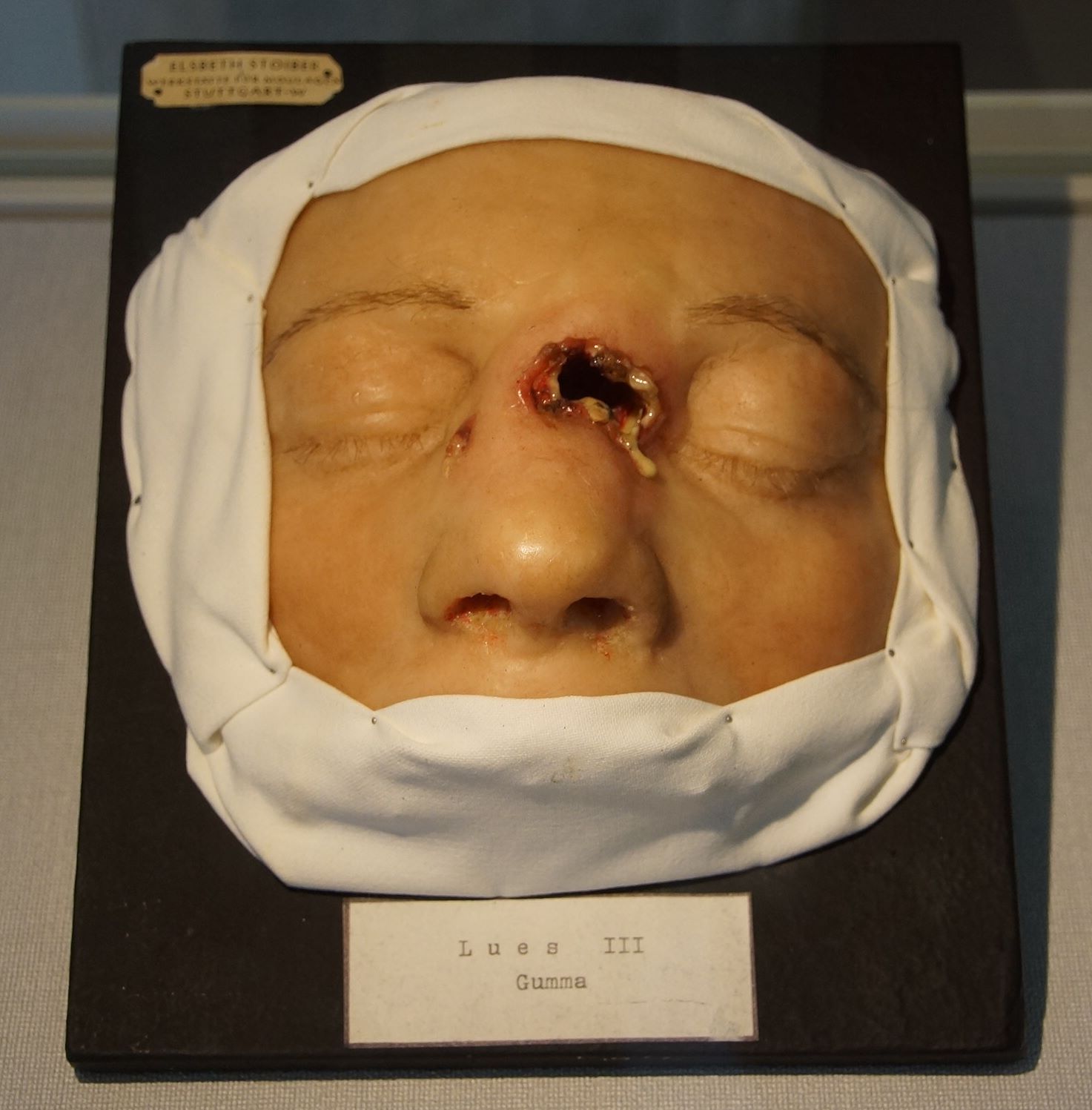Tabes Dorsalis physical examination
Jump to navigation
Jump to search
|
Tabes Dorsalis Microchapters |
|
Diagnosis |
|---|
|
Treatment |
|
Case Studies |
|
Tabes Dorsalis physical examination On the Web |
|
American Roentgen Ray Society Images of Tabes Dorsalis physical examination |
|
Risk calculators and risk factors for Tabes Dorsalis physical examination |
Editor-In-Chief: C. Michael Gibson, M.S., M.D. [1];Associate Editor(s)-in-Chief: Mohamadmostafa Jahansouz M.D.[2]
Overview
Patients with tabes dorsalis may be asymptomatic. Physical examination of patients with tabes dorsalis is usually remarkable for: Argyll-Robertson pupils, impaired vibratory and proprioception sense, broad base and sensory ataxic gait and positive romberg's test.
Physical Examination
- Physical examination of patients with tabes dorsalis is usually remarkable for: Argyll-Robertson pupils (bilateral small pupils that constrict when the patient focuses on a near object, but do not constrict when exposed to bright light), Impaired vibratory and proprioception sense, broad base and sensory ataxic gait and positive romberg's test (a test used for examination of neurological function for balance).
Appearance of the Patient
- Patients with tabes dorsalis may be asymptomatic.[1]
Vital Signs
- Usually vital signs are normal.[2]
Skin
Important cutanous findings in tabes dorsalis include:
- granulomatous skin lesions:
- One of the late manifestations of tertiary syphilis called gumma may be present
- Gummas are granulomatous reactions to long-term smoldering infection with Treponema pallidum and its residual antigens.[3]

Source:By NearEMPTiness (Wie Schönes Wissen schafft im MUT) [CC BY-SA 3.0 (https://creativecommons.org/licenses/by-sa/3.0)], via Wikimedia Commons, rID: 51340
HEENT
Abnormalities of the head include:[4][5]
- Icteric sclera may be present
- Argyll Robertson pupils may be present
- Hearing acuity may be reduced
Neck
- Cervical lymphadenopathy
- Nontender
- Mobile
- Small
Lungs
- Granulomatosis manifestations in lungs[6]
- Bilaterally coarse crackles
Neuromuscular
- Positive romberg test (a test used for examination of neurological function for balance) is one of the most important findings in physical examination of patients with tabes dorsalis[7]
- Patient is usually oriented to persons, place, and time
- Hyporeflexia or areflexia[8]
- Impaired balance bilateral Babinski's Reflex[9]
- Bilateral muscle weakness mostly in lower limbs[10]
- Argyll Robertson pupils (bilateral small pupils that constrict when the patient focuses on a near object, but do not constrict when exposed to bright light)[4]
- Bilateral sensory loss mainly in lower extremities[2]
- Broad base gait
- Sensory ataxic gait[2]
- Cranial nerve palsy (diplopia, mydriasis) caused by gummatous neurosyphilis[11]
- Finger-to-nose test is usually abnormal[12]
Extremities
- Charcot arthropathy (Charcot joint) of the foot[13]
- Muscle atrophy
References
- ↑ Crozatti LL, de Brito MH, Lopes BN, de Campos FP (2015). "Atypical behavioral and psychiatric symptoms: Neurosyphilis should always be considered". Autops Case Rep. 5 (3): 43–7. doi:10.4322/acr.2015.021. PMC 4636106. PMID 26558247.
- ↑ 2.0 2.1 2.2 Tso MK, Koo K, Tso GY (2008). "Neurosyphilis in a non-HIV patient: more than a psychiatric concern". Mcgill J Med. 11 (2): 160–3. PMC 2582679. PMID 19148316.
- ↑ Carlson JA, Dabiri G, Cribier B, Sell S (2011). "The immunopathobiology of syphilis: the manifestations and course of syphilis are determined by the level of delayed-type hypersensitivity". Am J Dermatopathol. 33 (5): 433–60. doi:10.1097/DAD.0b013e3181e8b587. PMC 3690623. PMID 21694502.
- ↑ 4.0 4.1 Thompson HS, Kardon RH (2006). "The Argyll Robertson pupil". J Neuroophthalmol. 26 (2): 134–8. doi:10.1097/01.wno.0000222971.09745.91. PMID 16845316.
- ↑ Nadol JB (1975). "Hearing loss of acquired syphilis: diagnosis confirmed by incudectomy". Laryngoscope. 85 (11 pt 1): 1888–97. doi:10.1288/00005537-197511000-00012. PMID 1195972.
- ↑ MORGAN AD, LLOYD WE, PRICE-THOMAS C (1952). "Tertiary syphilis of the lung and its diagnosis". Thorax. 7 (2): 125–33. PMC 1019150. PMID 14931376.
- ↑ French P (2007). "Syphilis". BMJ. 334 (7585): 143–7. doi:10.1136/bmj.39085.518148.BE. PMC 1779891. PMID 17235095.
- ↑ Pandey S (2011). "Magnetic resonance imaging of the spinal cord in a man with tabes dorsalis". J Spinal Cord Med. 34 (6): 609–11. doi:10.1179/2045772311Y.0000000041. PMC 3237288. PMID 22330117.
- ↑ Ahamed S, Varghese M, El Agib el N, Ganesa VS, Aysha M (2009). "Case of neurosyphilis presented as recurrent stroke". Oman Med J. 24 (2): 134–6. doi:10.5001/omj.2009.29. PMC 3273935. PMID 22334859.
- ↑ Matijosaitis V, Vaitkus A, Pauza V, Valiukeviciene S, Gleizniene R (2006). "Neurosyphilis manifesting as spinal transverse myelitis". Medicina (Kaunas). 42 (5): 401–5. PMID 16778468.
- ↑ Vogl T, Dresel S, Lochmüller H, Bergman C, Reimers C, Lissner J (1993). "Third cranial nerve palsy caused by gummatous neurosyphilis: MR findings". AJNR Am J Neuroradiol. 14 (6): 1329–31. PMID 8279327.
- ↑ Mehrabian S, Raycheva MR, Petrova EP, Tsankov NK, Traykov LD (2009). "Neurosyphilis presenting with dementia, chronic chorioretinitis and adverse reactions to treatment: a case report". Cases J. 2: 8334. doi:10.4076/1757-1626-2-8334. PMC 2769430. PMID 19918420.
- ↑ Kaynak G, Birsel O, Güven MF, Oğüt T (2013). "An overview of the Charcot foot pathophysiology". Diabet Foot Ankle. 4. doi:10.3402/dfa.v4i0.21117. PMC 3733015. PMID 23919113.